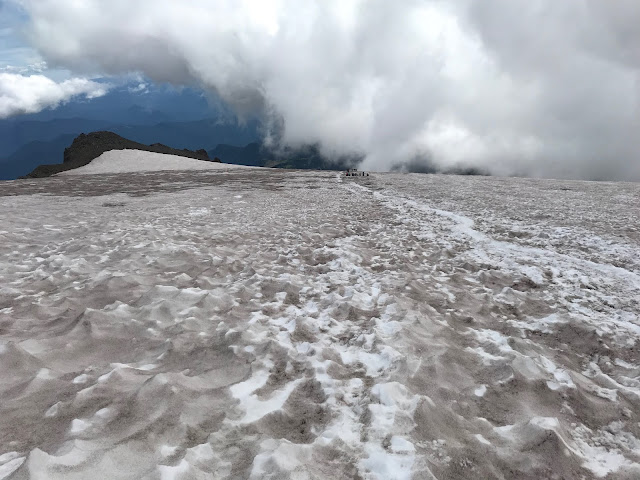 |
| Camp Schurman and Steamboat Prow from the Corridor. |
Climbing season on Mount Rainier's east side is winding down. Camp Schurman was a good spot for alpine solitude this week with only a handful of parties attempting to climb. Rangers waited out the high winds last weekend until Sunday afternoon to climb and explore the lower part of the route. Rangers climbed to 11,000 feet on the Corridor, and negotiated most of the route difficulties before turning around. September climbing on the Emmons/Winthrop requires a slightly different set of gear than early season. Bring ice screws, pickets, and sharp crampons along if attempting to climb. A shovel is a good idea as well so your party can chisel out a tent platform on the snow at Camp Schurman.
Getting to Camp Schurman
The Inter Glacier is crevassed and firm, with lots of exposed ice. Parties will need to don crampons and rope up for the Inter Glacier. An alternate route up Mount Ruth to Camp Curtis exists, but check with the rangers at White River for more information about traveling this way. From Camp Curtis, travel to the upper sites (#3,4,5) to find the climber's trail descending through the scree towards the Emmons. Parties have reported encountering difficulties getting across the moat onto the Emmons Glacier.
Camp Schurman to Emmons Flats
From the edge of the Prow above the helipad, the route climbs directly up through a maze of crevasses and exposed glacial ice. Variations further climber's right look more appealing, but dead end in large, open crevasses. Expect to belay your partners from pickets or screws over a crevasse or two in this section, as some crossings are pretty wide and arresting a fall would be otherwise impossible on the firm glacial ice here.
 |
| Looking up at the route from Emmons Flats. The Corridor is illuminated by sunlight on the left. |
Emmons Flats to the Corridor
From Emmons Flats, climb straight up though sun cups trending toward the bottom of the Corridor. Parties will encounter a set of large crevasses running horizontally that funnel into one remaining snow bridge allowing passage onto the Corridor. This bridge is narrow, but still well supported on the uphill side with snow. Inspect this bridge before crossing it, and belay your team across if necessary.
Corridor
The Corridor has firm snow, and sections of glacial ice. The travel is arduous and not exactly straightforward. Stay mostly climber's right as you ascend the Corridor. Countless crevasses cut through the route here, running in all directions. In several spots, the only way to build an anchor in the event of a crevasse fall is with ice screws. The route finding becomes more obvious as you approach the top of the Corridor.
Top of Corridor to Summit
Few parties have ascended above the Corridor in the last couple weeks. The best information about this section of the route can be found in the last Emmons blog post. The upper part of the route has more snow still, but don't expect easy travel to the summit. Climbing to the summit will make for a very long day. Be prepared with plenty of food, water, and anchor materials. As always, take a GPS track on the ascent to give your team something to follow on the way down.












































